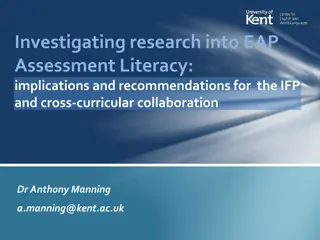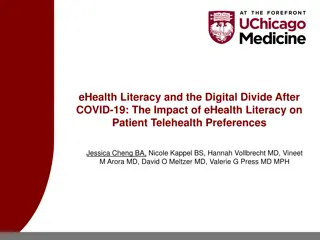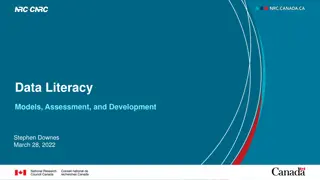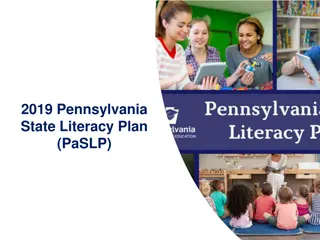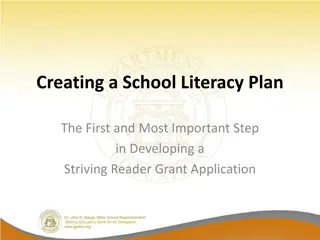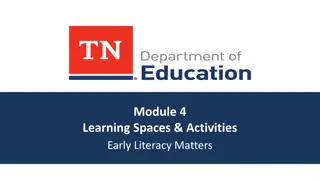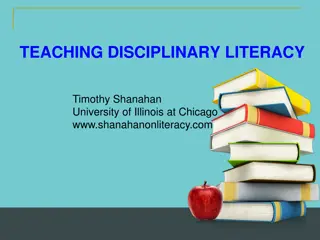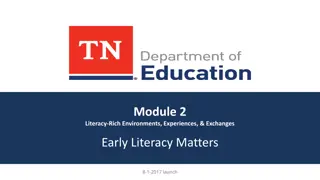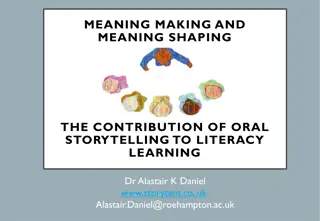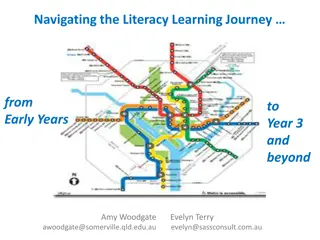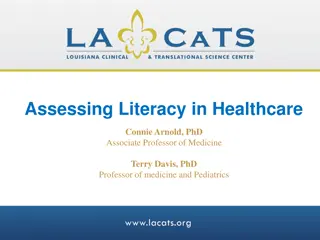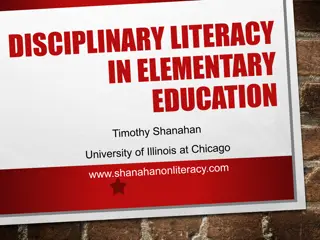Assessment Literacy Overview - Understanding Different Types of Assessment
Explore the purposes of different types of assessments within a balanced system and delve into the role of performance assessments in providing evidence of student learning. Discover how formative, interim, and summative assessments work together to inform teaching and learning effectively.
Download Presentation

Please find below an Image/Link to download the presentation.
The content on the website is provided AS IS for your information and personal use only. It may not be sold, licensed, or shared on other websites without obtaining consent from the author. Download presentation by click this link. If you encounter any issues during the download, it is possible that the publisher has removed the file from their server.
E N D
Presentation Transcript
Welcome and Introduction Mathematics 1
Session 1: Assessment Literacy Overview Purposes of This Training Learn about performance assessments, how they provide robust evidence of student learning, and how they can support a balanced assessment system. Collaboratively score student work from a Smarter Balanced performance task to build a common understanding of what student proficiency looks like. Review student work as the basis for reflecting on and responding to the evidence of learning that performance tasks can generate. 2
Session 1: Assessment Literacy Overview Who Is in the Room? Stand up if you are: 1. A classroom teacher 2. An instructional coach 3. A school-based administrator 4. A district administrator 5. Other 3
Session 1: Assessment Literacy Overview Note-Taking Guide Separate handout Session titles and objectives Topics or activities Space to write your comments and questions 4
Session 1: Assessment Literacy Overview Getting to Know You . . . 1. Choose one word that comes to mind when you think of student assessment. Share your word with your table group, including why you selected it. Write your word/phrase on a sticky note and bring your sticky note to the presenter. 2. When you ve finished your sticky notes, discuss in pairs: In what ways do you use assessment for learning and assessment of learning? 5
Session 1: Assessment Literacy Overview Session 1 Assessment Literacy Introduction Objectives: Develop a shared understanding of the intended purposes of different types of assessment within a balanced assessment system Understand the role of performance assessment in providing robust evidence of student learning Understand the role of performance assessment within the design of the Smarter Balanced Assessment System
Session 1: Assessment Literacy Overview Types of Assessment As we discuss three different types of assessment formative, interim, and summative use Handout 1.1 (pg. 2) to capture your notes. Think about how these different types of assessment work together to inform teaching and learning.
Session 1: Assessment Literacy Overview Formative Assessment Description: A planned process that takes place continuously during the course of teaching and learning to provide teachers and students with feedback to close the gap between current learning and desired goals. Margaret Heritage, Formative Assessment: Making It Happen in the Classroom Not a tool or an event, but a process Purposes: Provide immediate or very rapid feedback to teachers and students Provide evidence that can be used to adapt teaching and learning
Session 1: Assessment Literacy Overview Key Features of Formative Assessment: Clear lesson-learning goals and success criteria, so students understand what they are aiming for; Evidence of learning gathered during lessons to determine where students are relative to goals; A pedagogical response to evidence, including descriptive feedback, that supports learning by helping students answer: Where am I going? Where am I now? What are my next steps? Peer- and self-assessmentto strengthen students learning, efficacy, confidence, and autonomy; A collaborative classroom culture where students and teachers are partners in learning. (Linquanti, 2014) From the CA ELA/ELD Framework
Session 1: Assessment Literacy Overview Formative Assessment Some ways to elicit evidence for formative assessment: Observation of academic dialogue Questioning discussions Analysis of student work Peer- and self-assessment strategies What does formative assessment look like in your context?
Session 1: Assessment Literacy Overview Interim Assessment Description: Compares student understanding or performance against a set of learning standards or objectives May be administered at specified intervals over the course of an academic year May be common across classes or schools Purposes: Monitor students academic progress toward longer-term goals May predict students end-of-year performance Inform school improvement planning
Session 1: Assessment Literacy Overview Interim Assessment Examples of interim assessment: Common interim assessments Common performance tasks May include item banks Mid-term examinations Trimester examinations
Session 1: Assessment Literacy Overview Summative Assessment Description: May be referred to as a culminating assessment Provides information on students knowledge and skills relative to learning standards May be high-stakes Purposes: Provide an overall description of students learning status Monitor and evaluate student achievement at the group level Inform program-level and school-improvement planning
Session 1: Assessment Literacy Overview Summative Assessment Examples of large-scale summative assessment: National Assessment of Educational Progress (NAEP) Smarter Balanced Summative Assessments Partnership for Assessment of Readiness for College and Careers (PARCC) Assessments Specific statewide examinations Item banks A summative assessment may also be given at the school or classroom level End-of-unit assessment End-of-course assessment
Session 1: Assessment Literacy Overview Balanced Assessment Systems A comprehensive, coherent, and continuous system of assessment provides mutually complementary views of student learning, ensures that assessment within each cycle is focused on the same ultimate goal achievement of standards and pushes instruction and learning in a common direction (Herman, 2010). California ELA/ELD Framework What do you think are key features of a balanced assessment system?
Session 1: Assessment Literacy Overview Balanced and Coherent Assessment System Importance for teaching and learning Formative practices (teacher & student) Interim Summative (Abedi & Linquanti, 2012; Linquanti, 2014)
Session 1: Assessment Literacy Overview Assessment Cycles and Levels Formative assessment practice Interim/Benchmark assessment Summative assessment Formative assessment (CDE ELA/ELD Curriculum Framework, 2014, adapted from Herman & Heritage, 2007)
Session 1: Assessment Literacy Overview How Does Assessment Support Teaching and Learning? Take a moment to capture your thinking about how assessments inform teaching and learning in Handout 1.1: Types of Assessment Organizer (pg. 2) For reference, consider Handout 1.2: Types and Uses of Assessments within Assessment Cycles (pgs. 3-4).
Session 1: Assessment Literacy Overview Item Types Different item types elicit different information about student learning from students and can be used for different purposes: Selected response Constructed response Standardized performance tasks Curriculum-embedded performance tasks
The Smarter Balanced Assessment System
Session 1: Assessment Literacy Overview Why Performance Tasks? READ: Role of Smarter Balanced Performance Tasks (Handout 1.3 in your booklet (pg. 5)). DO: Mark 2 3 most important words and/or phrases in the handout (highlight, underline, or circle). 23
Session 1: Assessment Literacy Overview Blank title 24
Session 1: Assessment Literacy Overview Key Phrases Interaction with varied, rich stimuli Engages students in a scenario Solve a problem Create a product with a specific purpose Application of knowledge and skills Integration . . . across multiple standards Assesses what selected- and constructed-response items cannot 25
Session 1: Assessment Literacy Overview Reflect . . . Based on your analysis of the Role of Smarter Balanced Performance Tasks document, why is Smarter Balanced using performance tasks in its summative and interim assessments? 26
Smarter Balanced Assessment Performance Tasks CAT Samples Instruction
Session 1: Assessment Literacy Overview Four Principles of Performance Assessment . . . is learning by doing . . . links curriculum, instruction, and assessment . . . is assessment for and as learning . . . targets skills and knowledge that matter
Session 2: Deep Dive into a Smarter Balanced Performance Task 29
Session 2 Objectives Understand the design of a standardized math performance task and scoring tools Experience a performance task from the perspective of a student and unpack its learning demands and assessment purposes Collaboratively analyze student work and consider the implications for teaching and learning 30
Session 2A: Getting to Know the Task Individually Complete a Performance Task Grade 5: Clay Pottery Pages 62-64 32
Session 2A: Getting to Know the Task Initial Reactions At your table, discuss your experience with the task. What did you notice? What questions arose? What surprised you? 33
Session 2A: Getting to Know the Task Identifying the Math and Anticipating Issues What do students need to know and be able to do to accomplish the task? What would you expect your own students to struggle with in this task? Use Handout 2.1 to make some notes (pg. 7). 34
Session 2 Progress 2A Getting to Know the Task 2C Analyzing Student Work Complete performance task Read student responses to first item Initial reactions to the task Review and discuss Scoring Guide for first item Identify the mathematics and anticipate the issues Score student responses to item Compare and discuss scores for item 2B Unpacking the Task Repeat the steps of scoring with next hand-scored item(s) Alignment activity 2D Debriefing the Task 35
Session 2B: Unpacking the Task As we unpack the task, we will: Understand the Smarter Balanced Claims Align the task Reflect on the purpose of performance tasks 37
Session 2B: Unpacking the Task Let s consider what this task assesses: CCSS Standards for Mathematical Practice likely to be engaged by students working on this task Smarter Balanced Claims assessed by this task 38
Session 2B: Unpacking the Task Standards for Mathematical Practice 1. Make sense of problems and persevere in solving them. Reason abstractly and quantitatively. Construct viable arguments and critique the reasoning of others. Model with mathematics. Use appropriate tools strategically. Attend to precision. Look for and make use of structure. Look for and express regularity in repeated reasoning. 2. 3. 4. 5. 6. 7. 8. 39
Session 2B: Unpacking the Task What Constitutes a Claim? Claims are broad statements of an assessment system s learning outcomes. A claim is a statement of what students know and can do, based on the evidence they produce. Each Smarter Balanced Claim has multiple assessment targets defined by content standards to specify within the broader sense of the claim. 40
Session 2B: Unpacking the Task Overall Smarter Balanced Claims Grades 3 8 Students can demonstrate progress toward college and career readiness in mathematics. Grade 11 Students can demonstrate college and career readiness in mathematics. 41
Session 2B: Unpacking the Task Claim 1: Concepts and Procedures Students can explain and apply mathematical concepts and carry out mathematical procedures with precision and fluency. Blank title Solving Students can frame and solve a range of complex well-posed problems in pure and applied mathematics, making productive use of knowledge and problem solving strategies. Claim 2: Problem Claim 3: Communicating Reasoning Students can clearly and precisely construct viable arguments to support their own reasoning and to critique the reasoning of others. Claim 4: Data Analysis and Modeling Students can analyze complex, real-world scenarios and can construct and use mathematical models to interpret and solve problems. 42
Session 2B: Unpacking the Task Focus for Performance Tasks Evidence of Claim 1 shows that students can do math. Claim 1: Concepts and Procedures Claim 2: Problem Solving Evidence of Claims 2, 3, and 4 show that students can apply mathematics to novel situations, think and reason mathematically, and use math to analyze empirical situations, understand situations better, and improve decisions. Claim 3: Communicating Reasoning Claim 4: Data Analysis and Modeling 43
Session 2B: Unpacking the Task Aligning the Task Use the SBAC Claims and Practices cards to indicate on Handout 2.3 (pg. 10): 1. Which of the CCSS Standards for Mathematical Practice are likely to be engaged in this task? 2. Which of the Smarter Balanced Claims are assessed by this task? 44
Session 2B: Unpacking the Task Reflection on the purpose of performance tasks on a summative assessment What skills and abilities can be assessed by performance tasks that are hard to assess with other assessment types? What skills and abilities do you currently focus on in your own instructional practice, and which would you like to focus on more? 45
Lets Look at How Students Handled This Task 46
Session 2C: Analyzing Student Work As you look at student responses . . . Keep an eye out for: Successful approaches Examples of good explanations Common errors/misconceptions Use Handout 2.4 (pg. 11) to make notes. 47
Session 2C: Analyzing Student Work Individually review student responses to the first hand-scored item. Begin to make some notes on the Analyzing Student Work handout. 48
Session 2C: Analyzing Student Work Review and discuss Scoring Guide for first item. 49
Session 2C: Analyzing Student Work Individually score student responses to this item. When finished, please quietly record notes on the Analyzing Student Work handout. 50
Session 2C: Analyzing Student Work Compare and discuss scores. Review score rationales. 51





